One of the core decisions which you have to make while creating a survey is to decide the questions you want to ask from your target audience. The type of questions you choose determines the survey results and your future course of action to analyze those results and draw meaningful conclusions from the survey responses.
There are various types of questions to choose for your feedback form questions but they majorly fall under two categories, viz., closed-ended questions or open-ended questions. Closed-ended questions are the basis of all statistics and analytics used for quantitative research and applied to analyze survey responses and customer feedback and get actionable results.
In this article, we focus on closed-ended questions, what they are, the different types, explaining their advantages and disadvantages, and how they are different from open-ended questions.
TL;DR
- Closed-ended questions in surveys offer respondents predetermined response options, such as yes/no, ratings, or multiple-choice selections. They streamline data collection and are ideal for quick and quantifiable insights.
- Closed-ended questions are of various types - dichotomous, multiple-choice, and rating scale questions.
- It also emphasizes the advantages of closed-ended questions, such as ease of response and measurable data, but also highlights limitations like the inability to capture detailed opinions.
- When designing closed-ended surveys, there are a number of things that one needs to keep in mind to ensure the effectiveness and quality of customer data.
- With Zonka Feedback, you get over 30+ survey question types that can be quickly implemented to suit your business requirements. You can simply choose the type of closed-ended questions and start gathering quantitative data. To know more about the product schedule a demo with our team.
Build and send Closed-ended Survey Today 🔥
Choose from over 30+ question types, add your own themes, and create amazing surveys that people love answering.

What are Closed-ended Questions?
Closed-ended questions are those survey questions that ask respondents to answer from a set of pre-determined survey responses. They can be 1 to 5 rating survey questions, Likert scale questions, smiley face survey questions, yes/no questions, 1 to 10 rating scale survey questions, opinions from Strongly Agree to Strongly Disagree, or any other question that can be answered with a specific piece of information.
They don't typically invite elaboration or open discussion and the customer is not asked to write their opinion in their own words. Instead, they can choose one or multiple options from the provided choices.
An example of a closed-ended question is "Did you enjoy the movie?" because it can be answered with a straightforward yes or no.
These questions are useful when you want to gather specific information efficiently. Open-ended questions, on the other hand, encourage more detailed and varied responses. Let's understand the difference between both of them.
How they are different from Open-Ended Questions?
The core difference between closed-ended questions and open-ended questions is that no response options are provided with the open-ended questions, unlike the closed-ended ones. The respondents are provided with an open-ended space or text box where they can write their responses in their own words. Here are some points of differentiation explained below:
- Response Format - Closed-ended questions offer predefined response options or require a simple "yes" or "no" answer, while open-ended questions allow respondents to provide free-form answers without constraints.
- Level of Detail - Closed-ended questions typically yield concise and specific responses, whereas open-ended questions elicit more detailed, nuanced, and varied responses.
- Quantitative vs. Qualitative Data - Closed-ended questions generate quantitative data that is easy to analyze and quantify, while open-ended questions provide rich data that helps in qualitative research by offering deeper insights into respondents' opinions, attitudes, and experiences.
- Structured vs. Unstructured Responses - Closed-ended questions provide a structured framework for responses, guiding respondents to choose from predefined options, while open-ended questions offer an unstructured format, allowing respondents to express themselves freely.
- Suitability for Different Purposes - Closed-ended questions are suitable for collecting specific data, measuring attitudes, and conducting quantitative analysis, while open-ended questions are more appropriate for exploring complex issues, understanding motivations, and uncovering insights.
- Ease of Analysis - Closed-ended questions facilitate easy and efficient data analysis through tabulation and statistical methods, while open-ended questions require more time and effort for coding, categorization, and interpretation of responses.
Let's review a survey template to explore live examples of closed-ended questions.
Closed-ended Survey Example
There are different types of closed-ended survey templates that one can choose to capture feedback from their users. It could be around market research, product feedback, employee experience, patient feedback, or any other type of survey. We have given a simple example of an NPS survey that can be asked as a closed-ended survey question to capture insights from users regarding their likelihood to recommend the product.
Types of Closed-ended Questions & Examples
Closed-ended questions can be classified into different types, including dichotomous questions, multiple choice questions, rating scale questions, numerical rating scale questions, smiley rating questions, star rating questions, and Likert scale questions.
1. Dichotomous Questions or Yes/No Questions
Dichotomous survey questions are useful for gathering simple and straightforward feedback. With only two options for respondents to choose from, they provide a clear and concise way to gather information. Yes/no survey questions are a typical example of dichotomous questions. Here is an example of such a question:
- Have you ever traveled abroad?
- Yes
- No
Other examples can be questions with choices like true or false, agree or disagree, like or dislike, and thumbs up/down survey questions.
These types of questions are particularly useful when you want to collect data on a specific topic or behavior. By offering only two options, you can quickly gauge whether or not respondents have experience with a particular subject. This can be helpful for market research, understanding customer preferences, or even assessing the effectiveness of a product or service.
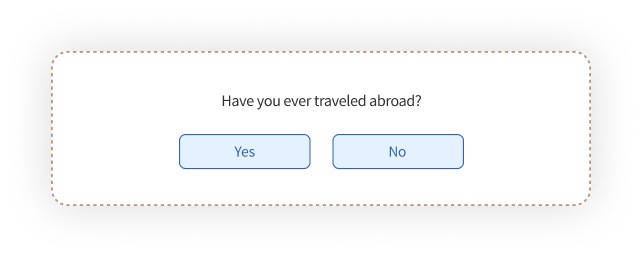
2. Multiple Choice Questions
Multiple-choice questions, on the other hand, offer respondents a set of predefined options to choose from. This format allows for greater flexibility in capturing customer preferences or opinions, as it offers a wider range of choices to select from. An example of a multiple-choice question could be:
- What is your favorite feature of the product?
- User Interface
- Performance
- Customer Support
- Payment Process
Some multiple-choice questions can also help with collecting demographic data from your customers. For instance, instead of asking customers to simply choose their favorite color, you can provide them with a list of various colors and shades to choose from, including popular options like blue, red, green, yellow, and more.
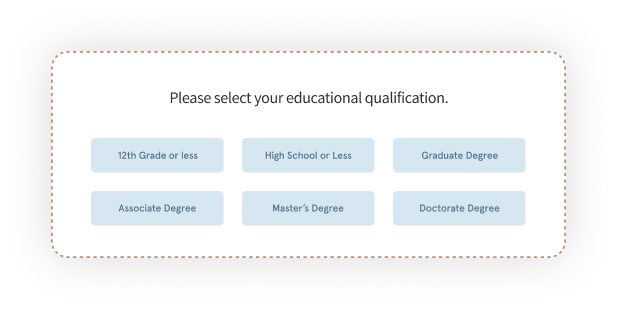
The above example of a simple single-response multiple-choice question. With the help of an effective survey software, you can also choose a question type that allows your respondents to select multiple responses among the options available to respond. Here is an example of a multiple-response multiple-choice question:
- Please select all of the factors that influenced your satisfaction with our customer service.
- Speed of response
- Clarity of communication
- Friendliness of staff
- Resolution of issue
- Availability of support options
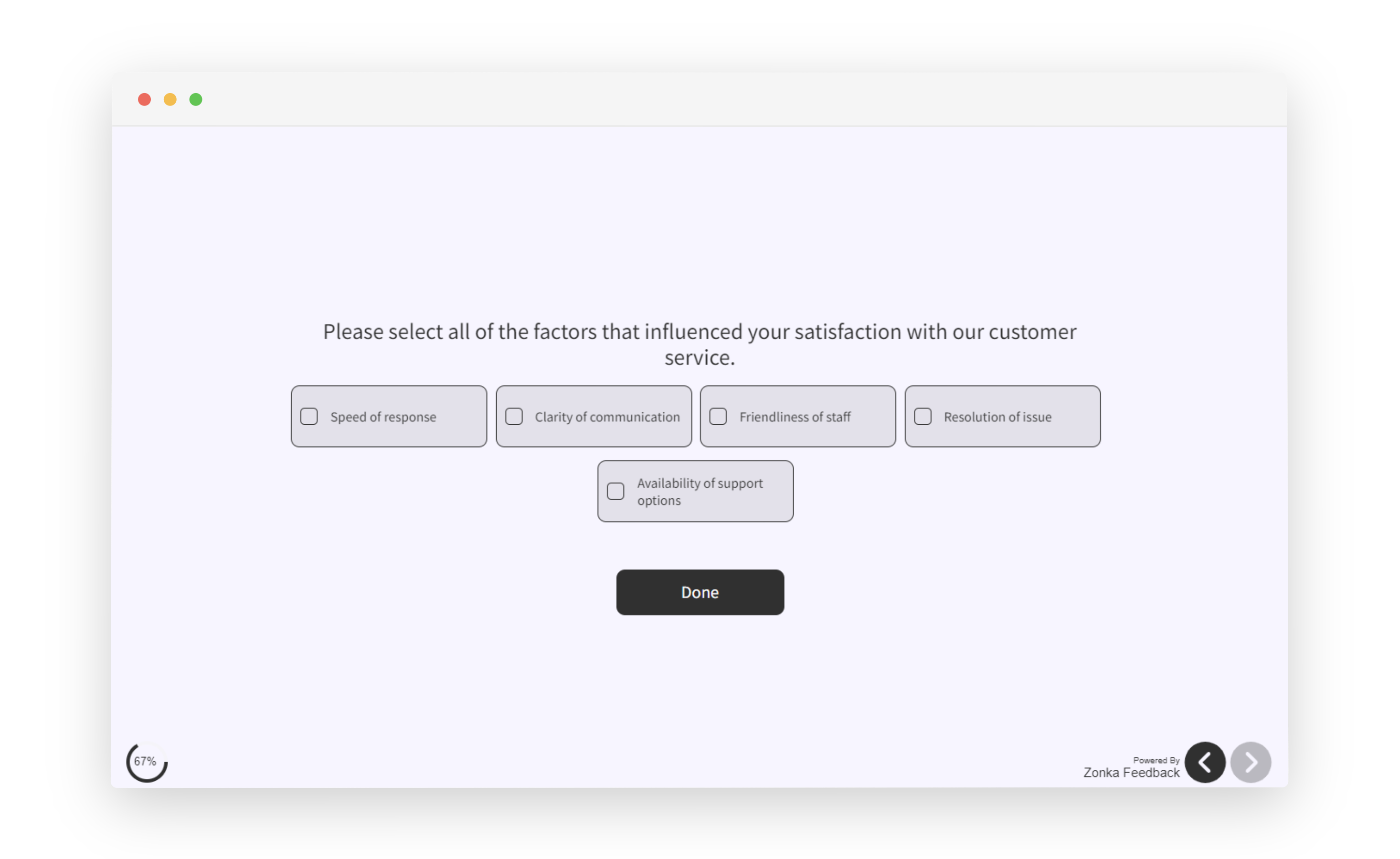
3. Rating Scale Questions
Rating scale questions involve asking respondents to rate a particular aspect using a numerical scale. This can be done using a numerical rating scale, where respondents rate on a scale from 1 to 10, or using smiley rating questions or star rating questions, where respondents choose a smiley face or a number of stars to indicate their satisfaction level.
- Likert scale questions are designed to measure the extent to which respondents agree or disagree with a statement. These Likert scale survey questions typically provide a range of options, such as strongly agree, agree, neutral, disagree, and strongly disagree. They are commonly used to assess customer opinions or attitudes.
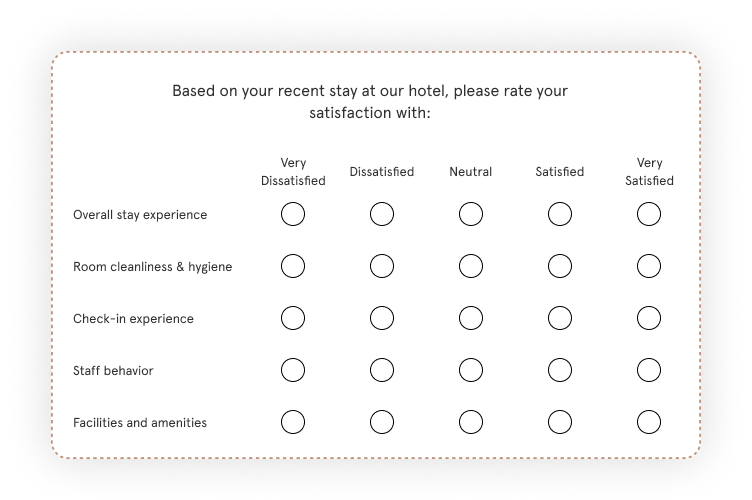
- Smiley Rating Questions allow respondents to choose from a range of smiley faces, each representing a different level of satisfaction or happiness. Smiley face survey questions are particularly useful when you want to capture emotional responses or gauge overall satisfaction.
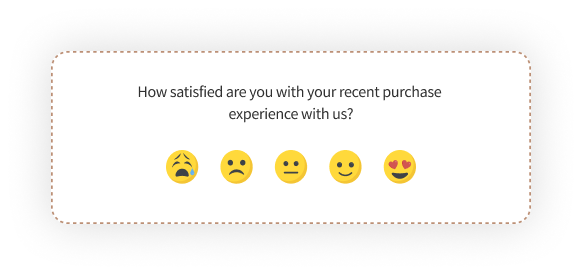
- Star Rating Questions, on the other hand, involve respondents selecting a certain number of stars to indicate their level of satisfaction. This format is commonly used for rating products, services, or experiences, and allows for easy comparison between different options. Below is an example of 5-star survey question.
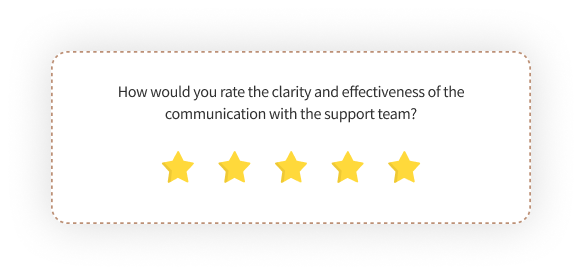
- Numerical Rating Scale Questions require respondents to rate a particular aspect using a numerical scale like a 5-point rating, 7-point, 10-point or 11-point rating scale. Questions like 1 to 10 rating scale survey questions, 1 to 5 rating scale survey questions, or 1 to 7 rating scale survey questions, are examples of numerical rating scale questions. This type of question provides a more precise measurement of satisfaction or opinion and can be useful when you want to collect quantitative data.
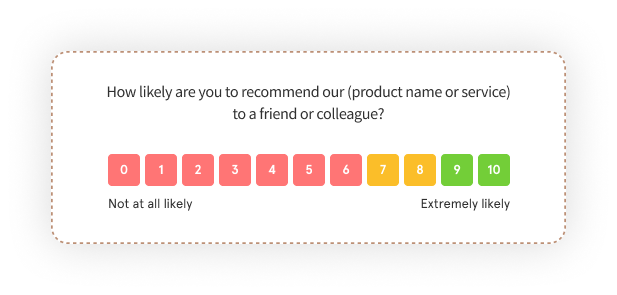
4. Ranking Survey Questions
Ranking survey questions are a type of closed-ended questions where respondents are asked to rank a set of options according to their preferences or priorities. Respondents typically assign a numerical rank or order to each option based on their perceived importance, preference, or relevance.
Here is an example of a Ranking question:
- Please rank the following aspects of your recent stay at our hotel from most to least satisfactory.
- Check-in process efficiency
- Cleanliness of room
- Quality of dining options
- Friendliness of staff
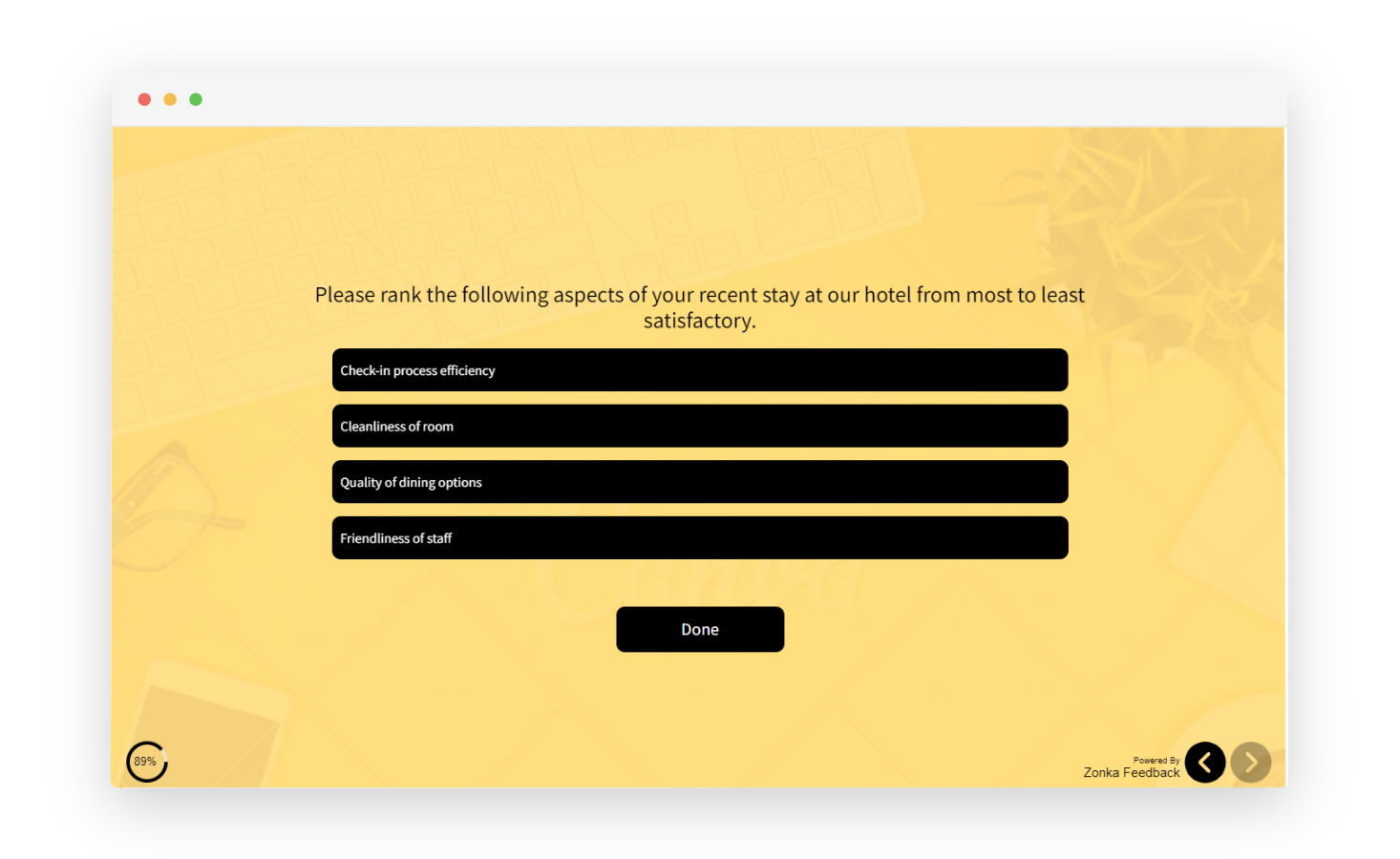
By incorporating these different types of closed-ended questions into your survey or feedback form, you can gather specific and quantitative data that can be easily analyzed and compared. These question formats offer simplicity, clarity, and ease of response for your customers, resulting in a higher response rate.
However, it's important to consider the limitations of closed-ended questions, such as the inability to capture detailed information or customer opinions. Therefore, it's recommended to use a combination of closed-ended and open-ended questions to gain a comprehensive understanding of customer feedback.
Best Practices for Using Closed-ended Questions
When it comes to using closed-ended questions in surveys or feedback forms, there are some best practices to keep in mind. These practices will help you maximize the effectiveness of your closed-ended questions and ensure that you gather accurate and valuable data from your respondents.
Here are the best practices for collecting quantifiable data using a close-ended question in your survey.
- Keep the questions clear and concise: Closed-ended questions should be easy to understand and answer. Avoid using complex or technical language that might confuse respondents. If you find yourself using overly complicated words, paraphrase text to make it look better. Keep the questions short and to the point, focusing on one specific aspect or topic.
- Use a variety of question formats: While Likert scale questions are commonly used, it's important to mix up the question formats to prevent survey fatigue and keep respondents engaged. Incorporate smiley rating questions, star rating questions, and numerical rating scale questions to capture different types of responses. With a good survey tool, you can also choose among more options like dropdown, radio buttons, checkbox, picture choice, and more.
- Provide a balanced range of answer options: When designing closed-ended questions, make sure to include a balanced range of answer options that cover all possible responses. For Likert scale questions, include options for both positive and negative sentiments. For star rating questions, include a sufficient number of stars to accurately reflect the respondent's level of satisfaction or dissatisfaction with a midpoint for average rating in between.
- Avoid leading or biased questions: Closed-ended questions should be neutral and unbiased, allowing respondents to provide their honest opinions. Avoid using leading or suggestive language that may influence their responses. Instead, focus on asking straightforward and objective questions.
- Pilot-test your questions: Before launching your survey or feedback form, it's important to pilot-test your closed-ended questions with a small group of respondents. This will help you identify any potential issues or misunderstandings and make necessary adjustments before collecting data from a larger sample size.
- Offer an "Other" or "Not Applicable" option: In some cases, respondents may have a response that doesn't fit within the provided answer options or find a question irrelevant to their situation. To accommodate these situations, include an "Other" option or an option that allows respondents to select "Not Applicable."
- Randomize answer options: To minimize response bias, consider randomizing the order of answer options for each closed-ended question as a specific order can influence respondents' answers. This will prevent any systematic bias that may occur when respondents consistently select the first or last option without carefully considering all the choices.
- Use skip logic or branching: If you have a series of closed-ended questions, consider using skip logic and question branching to ensure that respondents only answer questions that are relevant to them. This will help streamline the survey experience and prevent respondents from feeling overwhelmed by unnecessary questions.
- Keep survey length in mind: While closed-ended questions are efficient, it's important to keep the overall survey length in mind. Long surveys may lead to respondent fatigue and decrease response rates. Focus on asking the most important closed-ended questions and consider using open-ended questions for more detailed responses.
- Analyze and interpret data carefully through survey reporting: Once you've collected your closed-ended question data, take the time to analyze and interpret it carefully. Look for standardized data, patterns, trends, and correlations to gain insights into your customers' opinions or attitudes. Consider using visualizations through survey reports to present the data in a clear and concise manner.
By following these best practices, you can ensure that your closed-ended questions are effective in gathering specific and quantitative data. Remember to balance closed-ended questions with follow-up open-ended related questions to capture detailed information and customer opinions. An ideal example of this can be an NPS or CSAT survey that includes the core of the ultimate question which is closed-ended and asks the respondents to rate their experiences, followed by an open-ended question asking the primary reason for the rating shared.
With a well-designed survey or feedback form, you can gain valuable insights that will help drive informed decision-making and improve customer experiences.
When to Use Close-ended Questions?
Close-ended questions are a valuable tool in survey research and can be used in various situations to gather specific and quantitative data.
Here are some scenarios where close-ended questions are particularly beneficial:
1. Quantitative Data Collection
If your goal is to gather numerical data or specific statistics, close-ended questions are ideal. They allow you to quantify responses, making analysis and comparison straightforward. This is especially useful when you need to measure customer satisfaction, assess product feedback, or conduct market research.
2. Surveys with Large Sample Sizes
In surveys with a large number of respondents, close-ended questions are more practical. They enable efficient data collection and analysis, especially when time and resources are limited. With a fixed set of answer options, it becomes easier to process and interpret responses from a large sample size.
3. Quick Feedback or Check-Ins
For quick assessments or check-ins where you need concise information without delving into detailed explanations, close-ended questions are effective. They facilitate a swift response process, allowing respondents to provide feedback or opinions in a short amount of time. This is particularly useful for regular customer feedback or employee pulse surveys.
4. Comparative Analysis
When you want to compare responses across different groups or segments, close-ended questions provide a structured format. By using the same set of answer options for all respondents, you can easily analyze and identify patterns and trends. This is valuable for identifying customer preferences, understanding market segments, or evaluating the effectiveness of different strategies.
5. Standardized Assessments
In scenarios where standardized assessments or evaluations are necessary, close-ended questions help maintain consistency in the data collection process. This is common in academic or professional settings, where standardized surveys are used to measure knowledge, skills, or attitudes. Close-ended questions ensure that all respondents are presented with the same options and can be easily scored or compared.
6. Measuring Customer Satisfaction
Close-ended questions are commonly used in customer satisfaction surveys, such as Net Promoter Score (NPS) or Customer Satisfaction Score (CSAT) assessments. These questions provide a quantitative measure of satisfaction, allowing organizations to track changes over time or compare satisfaction levels across different customer segments. The structured format of close-ended questions makes it easier to calculate overall satisfaction scores and identify areas for improvement.
7. Statistical Research
In academic or scientific research that involves statistical analysis, close-ended questions are preferred. They contribute to the generation of measurable data for statistical interpretation. By using a fixed set of answer options, researchers can apply statistical techniques to analyze relationships, test hypotheses, or identify significant findings.
8. Time-Sensitive Surveys
In situations where respondents have limited time to complete a survey, close-ended questions are more time-efficient. This is crucial for maximizing response rates, especially in online surveys or when conducting research with busy individuals. With predefined answer options, respondents can quickly select their choices and provide feedback without spending excessive time.
9. Specific Information Gathering
When you need specific information on preferences, opinions, or behaviors, a close-ended question allows you to define response categories and gather targeted data. By providing a range of answer options, you can explore different aspects and collect data that aligns with your research objectives. This helps in understanding customer needs, identifying market trends, or tailoring products and services to meet specific requirements.
10. Online Surveys and Data Automation
Close-ended questions are well-suited for online surveys and automated data collection software processes. They facilitate quick data entry and analysis, enhancing the efficiency of online survey tools. With predefined answer options and automated data capture, organizations can streamline the survey administration process and generate real-time insights.
While close-ended questions offer efficiency and quantifiability, it's essential to balance them with open-ended questions in surveys to capture nuanced insights and gather qualitative data. The choice between close-ended and open-ended questions depends on the research objectives and the type of information you aim to collect. By understanding the advantages and best practices of close-ended questions, you can design surveys that provide valuable quantitative data through fixed responses while also allowing for deeper exploration of customer experiences and opinions.
Advantages of Using Closed-Ended Questions
There are many advantages of using closed-ended survey questions, especially when you desire to receive a high response rate from your busy customers. Let’s review them here.
- Easier and quicker to answer: Closed-ended questions can be answered easily without consuming much time as the customers just need to select one of the available answer options. They don’t need to think much and write the answers in their own words.
- Help in obtaining measurable and quantitative data: Closed-ended questions are perfect when you need to have quantitative statistics to measure different CX metrics like CSAT, Net Promoter Score, CES, etc. With a fixed number of answer options, you can easily ascertain the number of people selecting each option.
- Better understanding through answer options: At times, some customers do not fully understand the question, but when they look at the available options of answers, they get clarity of what is being asked. This type of survey collection that offers options to choose from makes it easier for the users to assess the question and answer accordingly.
- Customers are more likely to respond: Due to paucity of time, people nowadays avoid filling out time-consuming feedback forms, but when they are provided with answer options to choose from, they usually fill out the data collection forms, which helps in having a better response rate.
- Help to get rid of irrelevant answers: When open-ended questions are asked, the chances of irrelevant answers increase, which makes it difficult for you to gather and analyze feedback data. On the other hand, closed-ended questions have predefined relevant answers to choose from.
- Comparable answers: The answers to these feedback survey questions are easy to compare because only predefined answer options are available for the customers to choose from. You can easily compare the response of various demographic groups with each other.
- Easily customizable: Closed-ended questions are easy to replicate and modify as per the requirement. They can be customized on the basis of the type of survey, type of organization, type of products and services it provides, and response required, etc.

Disadvantages of Closed-Ended Questions
While there are plenty of advantages, there are also some drawbacks to using close-ended questions. Let’s review them here.
- Unable to provide detailed information: This has to be the biggest disadvantage of closed-ended questions. With the help of closed-ended questions, you can get to know the ratings of the CSAT survey or CES survey but not the details of it. You can even collect data from NPS surveys but not gain data regarding the reason behind the rating. Even if you give options regarding the reason for the rating, the customer cannot actually tell his full experience and why he rated low/high.
- Cannot help to receive customer opinions: Closed-ended questions cannot provide you the quantifiable data and information regarding what exactly the customer thinks and feels about your organization and the products/services. This hampers you from getting real customer insight.
- It is not possible to cover all possible answers: Every customer is different and has his own unique view. Even after trying your best to cover all possible answers in the options, there is a high chance that the answer desired by the customer is not available there. In such a situation, customers can get irritated and leave the survey midway or may choose a similar answer.
- More choices can create more confusion: Sometimes, there are so many choices for the customers to answer that they get confused about what to answer.
- Can suggest answers that the customer may not be thinking: There may be a case where a customer would not even be thinking about a particular aspect or idea, but the options in the closed-ended questions make him think in a completely different way.
- Customers having no opinion will also answer: It may be possible that a customer doesn’t have any opinion or knowledge about a particular aspect but just to complete the survey and give feedback, he chooses one of the available answer options. This can give you false information and irrelevant customer feedback data.
- Not possible to find out if the question is misinterpreted: If a customer misinterprets a question and answers accordingly, it would not be possible to ascertain that he has misunderstood unlike in open-ended questions where you can have an idea about the misinterpretation of a question by reading the answer from the customer.

Conclusion
In the end, it's all about how you collect survey responses that lead to high-quality quantitative data that can be analyzed to drive business decisions.
Unlike an open-ended question that gathers qualitative data, a closed-ended question allows users to share their insights quickly without having to think too much about it. All you need to do is carefully draft your feedback form by selecting a number of closed-ended and open-ended questions or a combination of both.
With a tool like Zonka Feedback, you can fully customize your feedback form using an online survey builder and choose from over 30+ feedback question types. Schedule a demo with our experts and see how it helps you create powerful surveys and collect actionable data to improve customer experience and boost your business growth.
Frequently Asked Questions
1. What types of closed-ended questions should I use in surveys?Use a variety of formats to capture different data types:
- Dichotomous (Yes/No, True/False) for quick checks
- Multiple-choice when you want specific categories
- Rating scales (1–5, 1–10, Likert) for measuring intensity or satisfaction
- Ranking to understand preference order
Closed-ended questions:
- Provide quantitative, easy-to-analyze data
- Are fast for respondents, boosting completion rates
- Ensure standardization and consistency across responses
They may:
- Miss depth and context—no room for narratives
- Restrict responses to provided options, possibly skewing insights
- Introduce bias if options are poorly crafted or leading
Best used when you need:
- Quantitative data for dashboard tracking or statistical analysis
- Surveys with large sample sizes for faster processing
- Quick feedback formats like NPS or CSAT
- Strong benchmarking or trend tracking
5. How do closed-ended questions help improve response rates?
Closed-ended questions require less effort to answer than open-ended ones. Respondents can quickly select from a list instead of thinking through and typing out full responses. This ease of response—especially on mobile devices—improves survey completion rates and overall user experience.
Follow these best practices:
- Use precise wording and avoid ambiguity
- Offer balanced options (e.g., Equal positive & negative response scales)
- Include “Other” or “Not applicable” to cover unexpected responses
- Consider randomizing choices to reduce order bias
Yes, by adding:
- Conditional branching: Trigger follow-up questions based on scores (e.g., ask “Why?” if rating <3)
- Mixed formats: Start with a rating and follow with open-ended “What could we improve?” for richer insight





.png)


.jpg)
.jpg)
.jpg)

.jpg)